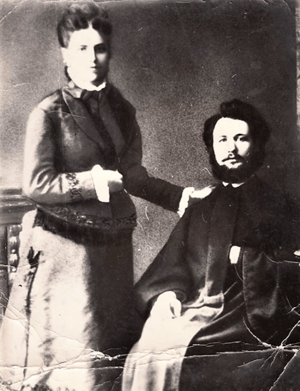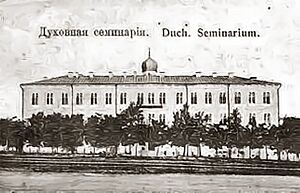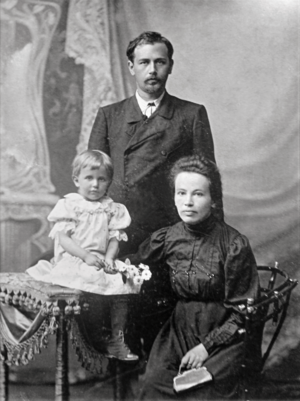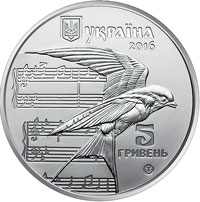Mykola Leontovych facts for kids
Mykola Dmytrovych Leontovych (born December 13, 1877 – died January 23, 1921) was a famous Ukrainian composer, conductor, and teacher. He was also an ethnomusicologist, which means he studied and collected folk music. His music was inspired by other Ukrainian composers and the Ukrainian National Music School.
Leontovych was best known for his a cappella (singing without instruments) choral music. He wrote original songs, church music, and beautiful arrangements of Ukrainian folk music.
He was born and grew up in Monastyrok, a village in Ukraine. He studied to become a priest at the Kamianets-Podilskyi Theological Seminary. When Ukraine became independent in 1917, he moved to Kyiv. There, he worked at the Kyiv Conservatory.
In 1904, he composed "Shchedryk". This song is now famous around the world as "Carol of the Bells". Sadly, Mykola Leontovych was murdered by a Soviet agent in 1921. He is seen as a martyr in the Ukrainian Autocephalous Orthodox Church. He is also remembered for his special church music, which was the first to be written in the modern Ukrainian language.
During his life, Leontovych's music became very popular in Ukraine. When his works were performed in Europe and North America, people called him "the Ukrainian Bach". Besides "Shchedryk," his music is mostly performed in Ukraine and by Ukrainians living in other countries.
Contents
Biography
Early Life and Musical Family
Mykola Leontovych was born on December 13, 1877. This was in a village called Monastyrok, in Ukraine. At that time, Ukraine was part of the Russian Empire. He was the oldest of five children.
Music was very important in his family. His father, Dmytro Leontovych, was a village priest. He also directed a school choir and played many instruments. These included the cello, violin, and guitar. Mykola's father gave him his first music lessons. Mykola's mother, Mariya Leontovych, was also a singer. All of Mykola's brothers and sisters grew up to have music careers.
In 1879, Mykola's father moved to serve as a priest in another village. In 1887, Mykola started school in Nemyriv. A year later, he moved to the Sharhorod Spiritual Beginners School. This school gave students full financial support. There, Mykola became very good at singing. He could easily read difficult religious music.
Studying at the Seminary
In 1892, Leontovych began studying at the Podolia Theological Seminary. This was in Kamianets-Podilskyi. Both his father and grandfather had studied there. His younger brother, Oleksandr, also attended the seminary.
While studying, Mykola improved his violin skills. He also learned to play other instruments, like the flute and harmonium. He sang in the seminary's choir. When an orchestra was formed, he joined it too. He studied music theory and started writing music for choirs. Some of his early works were arrangements of folk songs.
Leontovych also conducted the seminary's orchestra and choir. He secretly went to the opera in Kamianets-Podilskyi. After finishing his studies in 1899, he decided not to become a priest. Instead, he chose to be a school teacher.
Starting His Music Career
Leontovych's first teaching job began in September 1899. He taught singing and math at a school in Chukiv. He later wrote a book about his experiences. It was called How I Organised an Orchestra in a Village School.
In 1901, he started teaching at the Theological College in Tyvriv. He taught church music and worked with the choir. He also started an amateur orchestra. They performed folk songs and his own compositions. He began collecting folk songs from the Polissia region.
On March 22, 1902, Leontovych married Claudia Feropontovna Zholtkevych. Their first daughter, Halyna, was born in 1903. They later had another daughter, Yevheniya.
Because of money problems, Leontovych moved to Vinnytsia. He taught at the Church-Educators' College. He organized a choir and a concert band there. They played both religious and non-religious music.
In 1903 and 1904, Leontovych attended lectures in St. Petersburg. He studied music theory, harmony, and choral performance. In 1904, he became a certified choirmaster. Later that year, he taught singing in Grishino (now Pokrovsk). He formed a choir of workers. They sang folk songs from different cultures. His work caused problems with the authorities. In 1908, he had to leave his job and move back to Tulchyn.
Tulchyn Period and Success
Moving to Tulchyn was a very creative time for Leontovych. He taught music at the Tulchyn Eparchy Women's College. He became good friends with the composer Kyrylo Stetsenko. Stetsenko greatly admired Leontovych's music. He said Leontovych was a "famous music expert."
From 1909, Leontovych studied with the music expert Boleslav Yavorsky. He also became involved in the local theater. He led the local branch of Prosvita, a Ukrainian group that worked to protect and grow Ukrainian culture.
Leontovych wrote many choral arrangements of Ukrainian folk songs. In 1914, Stetsenko helped Leontovych's music be performed by a student choir in Kyiv. In December 1916, his arrangement of "Shchedryk" was performed. It was a huge success with music lovers in Kyiv.
Career in Kyiv
During the 1917 revolution, Leontovych moved to Kyiv. He worked as a conductor and composer. Many of his pieces became popular. After the Bolsheviks took over, Leontovych worked for the Ministry of Education. He also taught at the Music and Drama Institute. He helped create preschool education courses and organize choirs.
He taught choral conducting at the Kyiv Conservatory. He also taught at the Mykola Lysenko Institute of Music and Drama. He helped start the Ukrainian Republic Capella. When the White Army took Kyiv in 1919, they started to persecute Ukrainian intellectuals. To avoid arrest, Leontovych had to go back to Tulchyn.
Death
When Leontovych returned to Tulchyn, he started the city's first music school. The college where he used to work was closed. He also began working on an opera called The Mermaid's Easter. It was based on a Ukrainian fairy tale.
Early in the morning of January 23, 1921, Leontovych was shot. He was staying at his parents' home for the Eastern Orthodox Christmas holiday. An undercover Soviet agent, Afanasy Hrishchenko, had asked to stay the night. He shared a room with Leontovych. At 7:30 AM, the agent shot the composer and robbed the family. By the time a doctor arrived, Leontovych had died from blood loss.
Music
His Musical Works
Leontovych was a master of a cappella choral music. He wrote over 150 choral pieces. Most of these were inspired by Ukrainian folk songs. His works include arrangements of folk songs, religious music, and songs set to Ukrainian poems.
His most famous works are the New Year's song "Shchedryk" and "Dudaryk". His choral music is known for its rich harmonies and different vocal parts singing together.
Leontovych had a religious education. He supported the re-establishment of the Ukrainian Autocephalous Orthodox Church in 1918. During this time, he wrote many new religious songs. These included On the Resurrection of Christ and Praise ye the Name of the Lord. A very important work was his liturgy. It was first performed in Kyiv in 1919.
Mykola Leontovych was very hard on himself. He sometimes worked on a single choral piece for up to four years. He collected songs from Polissia. His "Second Collection of Songs from Polissia" was published in 1903. However, Leontovych was unhappy with it. He bought all 300 copies and had them destroyed.
Leontovych started working on his opera On the Water Nymph's Easter. He finished the first act by the end of 1920. But he was murdered before he could finish the opera. Other Ukrainian composers later tried to complete it. In 1977, a shorter version of the opera was performed in Kyiv.
The Story of "Shchedryk"
Mykola Leontovych's song "Shchedryk" is his most famous piece. It was first performed on December 29, 1916, in Kyiv.
The Ukrainian National Choir performed "Shchedryk" during a tour of Europe in 1920 and 1921. This made the song popular around the world. The first recording of the song was made in New York in 1922.
"Carol of the Bells"
"Shchedryk" was performed at Carnegie Hall in the United States. An American composer named Peter J. Wilhousky heard it. In 1936, he published the song with his own English words. These words are very different from the original Ukrainian ones. This English version is known as "Carol of the Bells".
Since 2004, "Carol of the Bells" has been arranged over 150 times. It is one of the most popular Christmas songs of the 20th century. It was ranked number 15 by the American Society of Composers, Authors and Publishers (ASCAP).
Commemoration
On February 1, 1921, artists and students gathered to remember Mykola Leontovych. This was just nine days after his death. They created the Committee for the Memory of Mykola Leontovych. This group later became the Leontovych Music Society. It promoted Ukrainian music until 1928.
Several music groups are named after the composer. The Leontovych Bandurist Capella was a male choir. Its members played the Ukrainian bandura (a stringed instrument). This choir was formed in Germany in 1946.
The Vinnytsia College of Arts and Culture is named after him. There is also a memorial museum dedicated to him in Tulchyn. Another museum was opened in 1977 in Markivka, where he was buried. In 2018, a statue of the composer was put up in Pokrovsk.
In 2002, a conference was held in Kamianets-Podilskyi to celebrate his 125th birthday. A special plaque was placed next to the old building of the Podolia Theological Seminary.
|
See also
- List of Ukrainian composers







